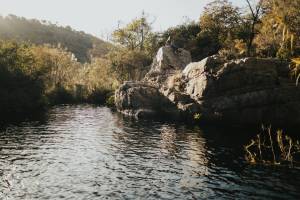
5 Refreshing Swimming Spots in and Around Johannesburg
Johannesburg may be landlocked, but that doesn’t mean you can’t enjoy a day of clear...
 20 November 2025
20 November 2025 
Day 1: Otter Hiking Trail General Info
Difficulty: Moderate
Risks: Rock hopping & slippery surfaces
Highlights: Guano Cave and Waterfall
Distance: 4.8 km, excluding exploring and swimming
Above: the Otter Hiking Trail – Day 1 Altitude Chart
After months of anticipation building up to the Otter Hiking Trail, the wait was finally over. All the reading-up, gathering of equipment and spots of training now had to be put to the test.
To be able to experience all that the Garden Route’s Otter Hiking Trail had to offer, we checked in before 10 am at the Storms River Camp. We paid our dues, collected maps and tide tables, raised our bags, smiled for a group picture, and set off walking anxiously past the starting point, down towards the coast.
This day was shared with many day hikers who continuously scanned our newly fitted bags and trekking poles. Some even paused for a chat; “Are you guys hiking the Otter Trail?” I was certain that they were envious.
The terrain of the Otter Trail Garden Route hike was rocky, and we were careful not to injure ourselves hopping along the boulders, whilst not giving in to the weight of our freshly loaded backpacks. First up was the Guano Cave, which was worth exploring. We left our bags at the entrance, and took along cameras, trekking poles and headlamps. The cave had some bats, a pond and was really slippery inside, which made for a great start to our adventure of hiking the Otter Trail.
Waves crashing against rocks along the Otter Trail Garden Route hike
Just past the three kilometre mark was the famous Otter Trail hike’s waterfall area. The waterfall and attached rock pool were a welcomed sight; especially to my sore feet. We spent some time there, swimming, having lunch and just chilling; enjoying the ocean backdrop. We were also lucky enough to spot a puff adder making its way out of the rock pool, using the rock formations as a pathway to its next destination. Judging from the inquisitive nature of the many tourists, who were standing right beside the snake, they were clearly not aware that the puff adder is one of the most dangerous snakes in Africa.
A puff adder making its way out of the water while hiking the Otter Trail
A kilometre and a bit more and we were in sight of the Ngubu Huts, our first overnight resting place. We were now all alone, no more day hikers. The huts were impressively situated and well maintained.
The first resting place of the Otter Trail hike included: two cabins, with six bunk-beds in each, a communal shelter with a braai (barbeque) area, a toilet with a view, as well as a cold water shower; neatly hidden away nearby.
Although we had a good supply of water on all day, the water could be erratic at times, or so we were told. The toilets were surprisingly clean; with no one being afraid to use them at any time.
The neighbourly bush buck at this camp showed off by posing for a few pictures and the Cape genets were well hidden in the bushes around the communal area, only appearing after we lit the braai. They have a beautiful leopard type coat and seemed so innocent… that was until we noticed that they were taking all the leftovers we were leaving around.
Before we knew it, day one of the Garden Route’s Otter Hiking Trail adventure was complete.